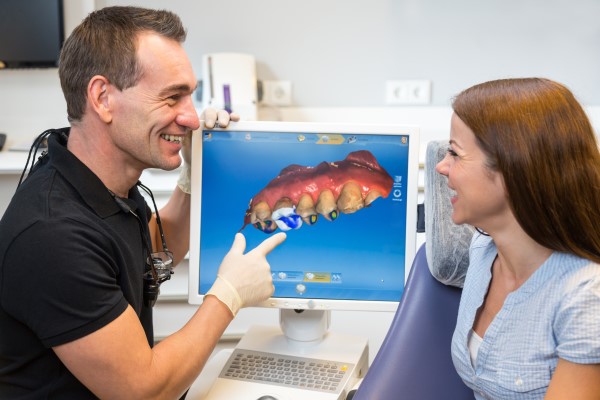What is Digital Dentistry?

Digital dentistry deals with the application of dental technology or devices that use digital or computer-based components. Traditional dental tools, in contrast, use mechanical or electrical procedures. The technology allows dental practices to improve the ways they deliver patient care. Above all, digital dentistry removes the manual aspects of dental processes. Therefore, dentists can provide treatment in a more efficient and automated manner.
Types of digital dentistry technology
In dental practices, there are different diagnostic and treatment options that need the application of computer-driven technology. Some of the common types of dental technology include:
Digital radiography
This is the application of optical face scanners to create a clear image of the teeth and dental impressions. The dentist can view, print or assess the scans during a dental appointment. Also, digital radiographs produce about 70 percent less radiation compared to traditional x-rays and are more ecological. Some of the different types of 3D intra-oral scanners include 3Shape TRIOS®, iTero® and CEREC® Omnicam.
CAD/CAM and 3D printing
Computer-aided design or manufacturing and 3D printing have made the design and production of dental restorations more effective for dentists. Digital dentistry allows the dentist to design, fabricate and place dental restorations such as crowns, bridges and veneers on the same day. Usually, a dental lab will create the restoration, and the process may require up to three weeks. This new technology means that patients can get the final restoration in one appointment.
Cone-beam computed tomography imaging (CBCT)
A cone-beam CT is a spinning x-ray device that enables a three-dimensional view of the teeth and the entire oral cavity. Also, the imaging method detects oral issues that are not visible with normal x-ray scans. A CBCT can pinpoint the location of the teeth and their roots.
Intra-oral cameras
Intra-oral cameras produce clear, accurate pictures of the mouth. With a wand-like shape, the camera can magnify pictures on a computer screen in real-time. This allows patients to see what is going on in their mouths. Also, the intra-oral camera can help dentists see hard-to-reach areas clearly. This can be helpful when dealing with issues like a fractured tooth.
The benefits of digital dentistry
The invention of new technologies and techniques in dentistry presents many benefits for patients, including:
Accurate diagnosis – digital dentistry techniques allow the dentist to identify, diagnose and treat oral conditions more accurately, especially in the early stages. Unlike regular x-ray scans, it is possible to enlarge digital radiography images for a more accurate representation of a patient’s teeth and oral cavity.
Better patient experience – digital imaging allows dentists to limit the use of traditional impression materials, which is uncomfortable for some. Rather than take impressions, the dentist can easily take a dental scan with the 3D scanner, which is more convenient; no more trays or biting into impression materials.
In conclusion
Digital dentistry can help patients save time and money. Since restorations can be completed in one day, there is no need for multiple appointments or waiting several days for the tooth restoration procedure. To learn more about this technology, talk to your dentist during your next appointment.
Request an appointment here: https://www.palmbeachdentistry.com or call Palm Beach Dentistry at (561) 225-2057 for an appointment in our Delray Beach office.
Check out what others are saying about our services on Yelp: Read our Yelp reviews.
Recent Posts
Routine dental care is one of the most important factors contributing to good dental health. While going to the dentist twice a year is the standard rule of thumb, the frequency of the visits ultimately depends on the patient's needs and the recommendation of the dentist. Learn how often routine care should be scheduled and…
Prioritizing routine dental care is necessary for good health. Unfortunately, some people can find it difficult to care properly for their teeth by brushing, flossing, and seeing a dentist on a regular basis. Patients who disregard dental hygiene and professional care need immediate action to prevent dangerous outcomes.In addition to an unsightly smile, failing to…
Many people may believe that they do not have time for routine dental care, which consists of daily brushing and flossing as well as periodic cleaning by a dentist. Admittedly, these tasks do take some time but should be a priority even in a busy schedule. People who do not take time for brushing, flossing,…
Professional dental cleanings are integral for keeping your mouth healthy. They remove plaque and tartar (hardened plaque) that regular brushing and flossing cannot, leaving your teeth and gums refreshed. Maintaining healthy habits that keep your smile bright and strong is essential to make the most of a dental cleaning. Caring for your teeth properly after…


